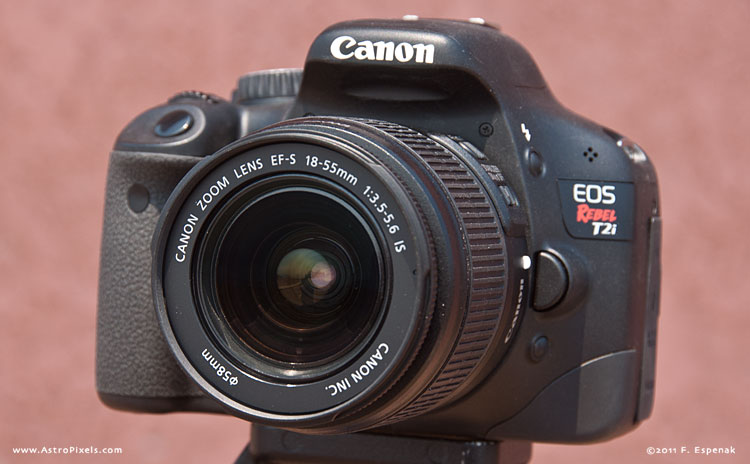I must confess I've been a Nikon SLR shooter since the early 1970s. Once you become ensconced into a particular camera manufacturer's product line, the investment in good lenses makes it difficult (i.e., expensive) to switch to another brand. This was true back in the age of 35mm film, and it's just as true today with digital SLRs (DSLRs).
In recent years I've become a little envious of Canon and their line of DSLRs. They always seem one step ahead of Nikon. Although Nikon occasionally leapfrogs past Canon, it's always a temporary victory since Canon seems to introduce new models at a breakneck pace.
In August 2003, Canon introduced a new line of low cost consumer DSLRs with the 6-megapixel Digital Rebel (EOS 300D). It wasn't long before some enterprising astrophotographers removed the infrared blocking filter in the Rebel and thereby dramatically increasing its sensitivity to H-alpha, the deep red hydrogen emission found in many diffuse nebulae.
In the ensuing years, Canon has stayed abreast with frequent updates to the Rebel line. The Rebel XSi (450D), XS (1000D), T1i (500D), T2i (550D) & T3 (1100D) have all proven to be worthy astrocameras especially when the infrared blocking filter is removed or replaced with a new filter that transmits the all important H-alpha line.
Wouldn't it be great to buy one of these cheap Rebels and have it modified as a dedicated astrocamera? Too bad I have all these great Nikkor lenses that won't fit. But then I learned that a cheap $15 Fotodiox adapter was available that allowed you to mount Nikkor lenses on a Canon body. But which Canon body to get?
The Canon EOS 550D (Rebel T2i) was introduced in August 2010. This 18-megapixel DSLR offers great image quality and a feature set and that could only have been dreamed of a few years ago. With a list price of $799 (body only), it's capable of shooting at 3.7fps, HD movies (with manual control and selectable frame rates), live view (with 10x zoom), and an ISO range of 100-6400 (expansion to 12800).
After doing some research on the web, I chose Gary Honis DSLR Modification Service to replace the infrared blocking filter with a Baader UV/IR filter. The Baader filter transmits H-Alpha emission from deep sky objects. It also blocks higher infrared wavelengths that cause poor focus and bloated stars in refractors and camera lenses. The Baader filter is the same thickness as the original Canon IR filter so the camera's autofocus feature and optical viewfinder work just like the original un-modified camera. In addition, the camera's custom white balance can be used to correct color balance for regular photography.
I ordered a Canon EOS 550D in January 2011 and had it shipped directly from Adorama to Gary Honis. The email messages from Gary were very informative and he made every effort to get my camera modified and delivered quickly. His DSLR Modification Service comes with my highest recommendation.
By February 2011, I had my newly modified Canon EOS 550D and immediately set about testing it with some of my favorite Nikkor lenses (105mm f/2.5, 180mm f/2.8 and 300mm f/2.8). The images are remarkable, especially when I use the Canon Live View feature to carefully focus on a star field.
I'm so pleased with the Canon EOS 550D that I selected it for a project to image all 110 deep sky objects from the Messier Catalog using the Takahashi Epsilon 180 Hyperbolic Astrograph. Visit the Messier Catalog Photo Gallery to see the image quality delivered by this camera and telescope combination.
For more information, see the DP Review of the Canon EOS 550D.
| Canon EOS 550D (Rebel T2i) - Some Specifications | |
|---|---|
| Sensor | • 18.7 million effective pixels • 18.0 million total pixels • 22.3 x 14.9 mm CMOS sensor • RGB Color Filter Array • Built-in low-pass filter with self cleaning unit • 3:2 aspect ratio |
| Dust reduction | • Low-pass filter vibration at power-on (can be interrupted) • Anti-static coating on sensor surfaces • Software based dust-removal (camera maps dust, removed later) |
| Image sizes | • 5184 x 3456 • 3456 x 2304 • 2592 x 1728 |
| Still image formats | • RAW (.CR2 14-bit) • RAW (.CR2 14-bit) + JPEG Large/Fine • JPEG (EXIF 2.21) - Fine, Normal |
| Movie recording | • 1920 x 1080 (1080p, 16:9) @ 30/25/24 fps • 1280 x 720 (720p, 16:9) @ 60/50 fps • 640 x 480 (4:3) @ 60/50 fps • Quicktime MOV format (H.264 video,linear PCM audio) • Up to 29 min 59 sec (or max file size 4 GB) |
| Exposure compen. | • +/- 5.0 EV • 0.5 or 0.3 EV increments |
| Sensitivity | • ISO 100 to 6400 • H1 expansion (ISO 12800 equiv.) |
| Mirror lockup | Yes (custom function) |
| Viewfinder | • Pentamirror • 95% frame coverage • Magnification: 0.87x (-1 diopter with 50 mm lens at infinity) • Eyepoint: 19 mm • Dioptric adjustment: -3.0 to +1.0 diopter • Fixed precision matte |
| Storage | • SD / SDHC card • SDXC card |
| Power | • Lithium-Ion LP-E8 rechargeable
battery • Approx 440 shots (23°C AE 50%, FE 50%), CIPA standard • 4 level battery life display • Optional ACK-E8 AC adapter kit |
| Dimensions | 129 x 98 x 75 mm (5.1 x 3.9 x 2.9 in) |
| Weight (inc batt/card) |
530 g (1.17 lb) |
